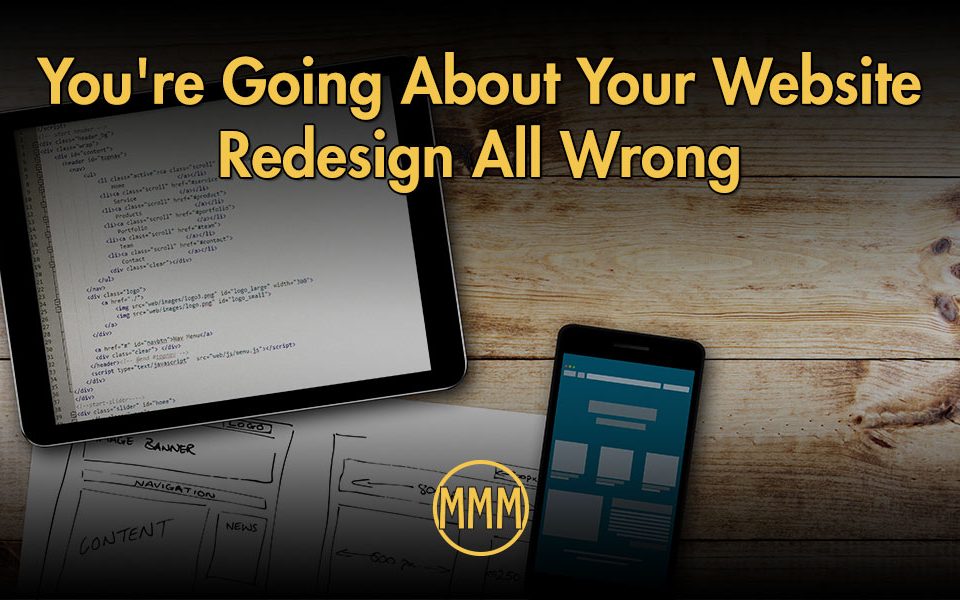Ten Questions to Answer Before You Redesign Your Website

Is There Video in Your Content Marketing Future?
June 28, 2016
3 Things to Look at on Your Website for Better Conversions on Mobile
July 26, 2016The reason for redesigning your website comes in various flavors. It could be an outdated look or visitors are not becoming customers or maybe it is just time to update it. Whatever your reason there needs to be a plan to evaluate where you are and where you would like to go.
Like any construction project, there needs to be a blueprint. I put together a list of ten questions you should be asking yourself before you start your redesign.
-
What are visitors looking to find on your website?
Unless they are a spam bot, a visitor clicks to your website looking for something. What is that something? Knowing what your customer will be looking for is the key to getting this question right. User tip: answering questions two, three and four can help formulate this answer.
-
Who will be the ideal visitor?
Creating a demographic make-up of your customer is key to finding your ideal visitor. By knowing your demographic, you can make decision such as fonts, colors, and simplicity. This will also give insight into effective call to actions when that visitor comes to the site.
-
Why are they there?
There can be several reasons why a visitor comes to a site. I believe the most common is to find information. Is your information easy to find? One key element in your redesign is leading the visitor to the information they are seeking quickly. If it can’t be found by a quick scan of the homepage, they are moving on.
-
What solutions are you providing for your visitors?
This is probably the most important question. Make it clear on your website the solution you provide and how to achieve that solution with the minimal amount of clicks.
-
How will they be visiting your site? Desktop? Mobile?
It is easy to fall into the trap of designing for the 27 inch monitor on your desk. Studies have shown that the millennial generation will be increasingly doing more browsing and commerce on their smartphone, the smallest screen. Now, with that said…
-
Are you giving them a positive experience on both?
User experience on a desktop and on a phone are apples and oranges. From the control device, a mouse versus your finger, to the size of the graphics on the screen, to have a mobile site be just responsive is not enough. The user experience has to be designed for that small screen and most likely in portrait orientation which means you will have a tall and long viewing space for your visitor. You need to go beyond making everything smaller and calling it mobile friendly.
-
What search terms are being used?
This will require a little bit of research and creativity. If you are competing against big brands or established companies, getting to the top of the short one or two search term search results page is going to be a long term goal but what can you do now? Start by researching how they are searching for your product or service. Are they typing in questions? Are they using longer phrases (more than four words)? You can use a tool like Google’s Keyword Planner or Moz Keyword Planner to determine the phrases that people are using to search for your product or service. The benefit is that many of the big brands aren’t optimized for longer search terms. Basically, you can dominate that search page and drive traffic without running up against larger brands.
-
What is going to make your visitors become a customer?
Once you have them on the site, there needs to be a way to close the deal. That process should be painfully obvious and simple to achieve. If you have too many hoops, you may lose the sale.
However, many visitors are in exploratory mode. They aren’t quite ready. This is an opportunity to build your email list or social media following. There could be many steps until the final sale is completed but there are many opportunities to stay engaged with a visitor until they are ready to make a purchase.
-
How will you measure success?
Success comes in many forms but it can’t just be a closed sale. There are visitor goals, conversion rates to look at as well. How are those visitors affecting your bottom line? I’ve heard many people talk about that if they can close one sale, the site will pay for itself. What if that sale takes several months to close? Is it still worth it? With that said, in that timespan you could have doubled your list and now you have twice as many potential customers in the pipeline. Is it still worth it? Think of success as a culmination of small and large achievements. You should be looking long and short term. Evaluate periodically and make changes if necessary.
-
How will you avoid failure?
Now that you are willing to spend the money to redesign your site, how can you avoid wasting that money and be in the same situation you are now? Setting goals is a major factor. Ultimately, every member of the team from the owner to the web designer needs to be on the same page in order for the redesign to work. Setting lofty goals will only follow with disappointment, meetings and firings. Overtaking Amazon is admirable but not likely, at least not at first. Even Amazon took time to rise to its dominant level.
There’s an expression putting “lipstick on a pig”. You don’t want your redesign to be the pig.




